Key Takeaways:
- GPS tracking devices, like the ones offered by GoCodes, allow you to monitor the whereabouts of your valuable equipment and vehicles consistently, thereby enhancing safety and preventing theft.
- Dash cameras serve as an excellent tool to enhance driver accountability and increase awareness of their surroundings, leading to improved road safety for everyone.
- Onboard diagnostics systems can monitor and interpret diagnostic fault codes in real time, enabling faster and more effective diagnosis and resolution of problems.
- Electronic logging devices collect a wide array of data needed for precise hours of service tracking and maximizing available driver hours. This streamlines record-keeping and ensures that hours of service records are precise, current, and tamper-resistant.
Telematics systems are well-known for providing users with copious amounts of invaluable vehicle data, in turn boosting the overall efficiency and profitability of fleets.
But how exactly do they achieve this?
Or, more precisely, what kind of technologies are involved in compiling this rich asset data?
Well, there are various types of telematics devices, each with its own distinct purpose, role, and data-gathering capability.
And today, we’ll explore these devices, focusing on the five most common ones in fleet management.
We’ll be examining what they enable you to monitor, explain the advantages of the data they provide, and perhaps even outline some drawbacks of these technologies.
By the end of this article, you’ll be more than well-equipped to select the telematics system that best suits your unique requirements.
Let’s delve in.
In this article...
GPS
GPS tracking devices are the heartbeat of modern telematics systems, as well as efficient fleet management in general.
Once installed in your vehicles, they calculate their own positions using satellite signals, transmit the data to servers for interpretation, and then relay it to your fleet management software.

But what does that mean for you?
It means you can whip out your phone or fire up your computer and watch, in real-time, as each vehicle moves across the digital map with pinpoint precision.
And let’s face it: the ability to do so is indispensable for any fleet manager out there, as it allows them to:
- prevent theft,
- optimize resource allocation,
- ensure drivers adhere to designated routes,
- manage fuel consumption more effectively, and
- enhance safety.
It’s downright remarkable how much can be achieved with these small devices.
Just take a look at our GoCodes real-time trackers below.
They seem pretty unassuming, don’t they?
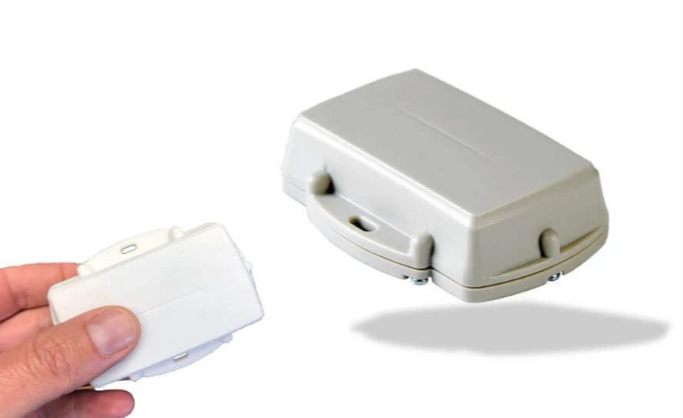
Still, they are quite powerful.
GoCodes GPS tracking devices provide minute-by-minute GPS location updates, enabling you to track your valuable equipment and vehicles at all times, even while they’re in transit.
But that’s not all.
Our GPS trackers work in tandem with our asset management system, further enhancing job site security by letting you set up geofences around your job sites.
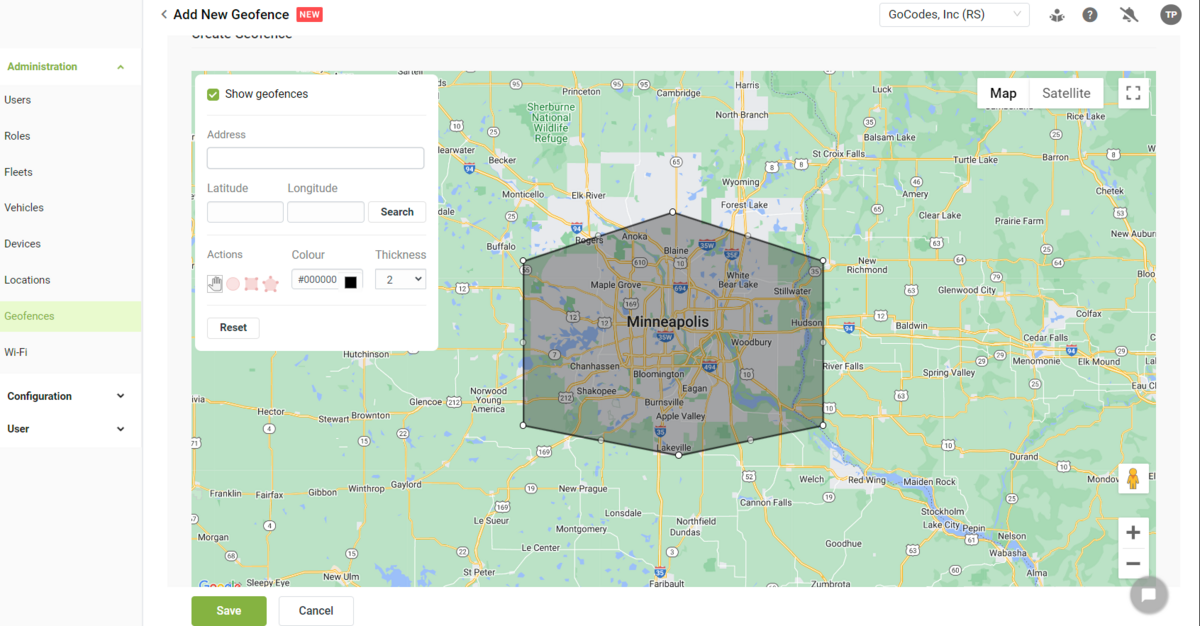
You simply define an area on a digital map that your assets can’t leave, and if any suspicious activity is detected, you’ll receive an immediate alert, allowing you to step in right away and address the problem.
Overall, if you’re considering investing in telematics, definitely make GPS your top consideration.
It can be used in pretty much any aspect of fleet management, from boosting security to optimizing resource allocation—almost like a Swiss Army knife of fleet control.
Plus, the technology is incredibly user-friendly and straightforward to use, too.
Dash Cameras
While GPS tells you where your drivers are, dash cameras show you exactly what’s happening around the vehicle as they navigate the roads.
As such, these compact video devices, mounted on dashboards or windshields, are a great tool for boosting driver accountability and awareness of their surroundings, ultimately making the roads much safer for everyone.
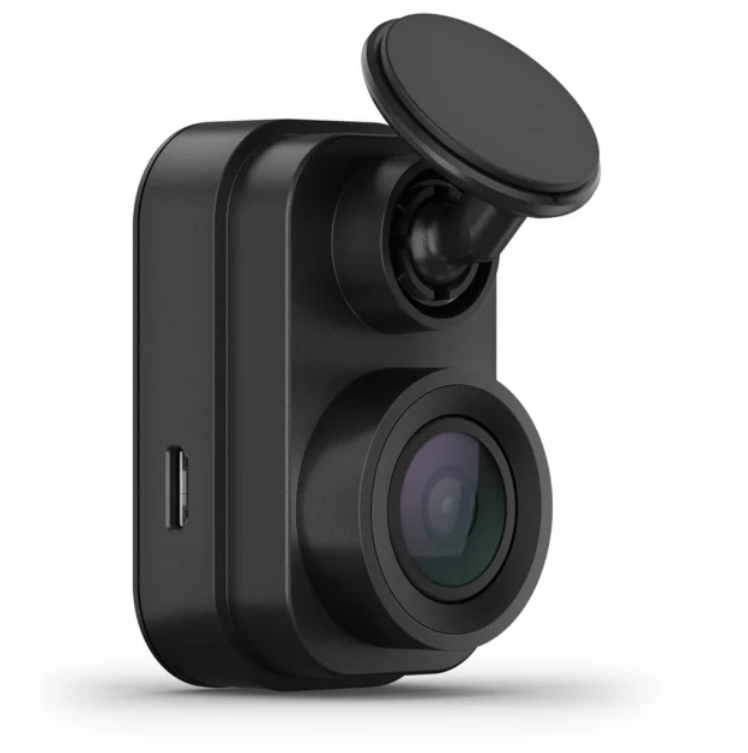
Even in the unfortunate event of an accident, the recorded footage acts as concrete evidence, offering an unbiased account of the incident.
According to a survey by GPS Insight, dashcam adoption among fleet managers seems to be on the rise.
In 2022, when the survey was conducted, 32% had already integrated dash cams, with another 46% gearing up to do so within a year.
And those who do use this technology seem to have nothing but words of praise for it, claiming it really helps them manage drivers, boost safety, and even reduce insurance and accident costs.

Yes, the financial benefits of dash cameras seem to be surprisingly substantial.
KeepTruckin’s dash cam ROI survey reveals that those who use this tech and provide frequent driver coaching save approximately $72,800 annually.
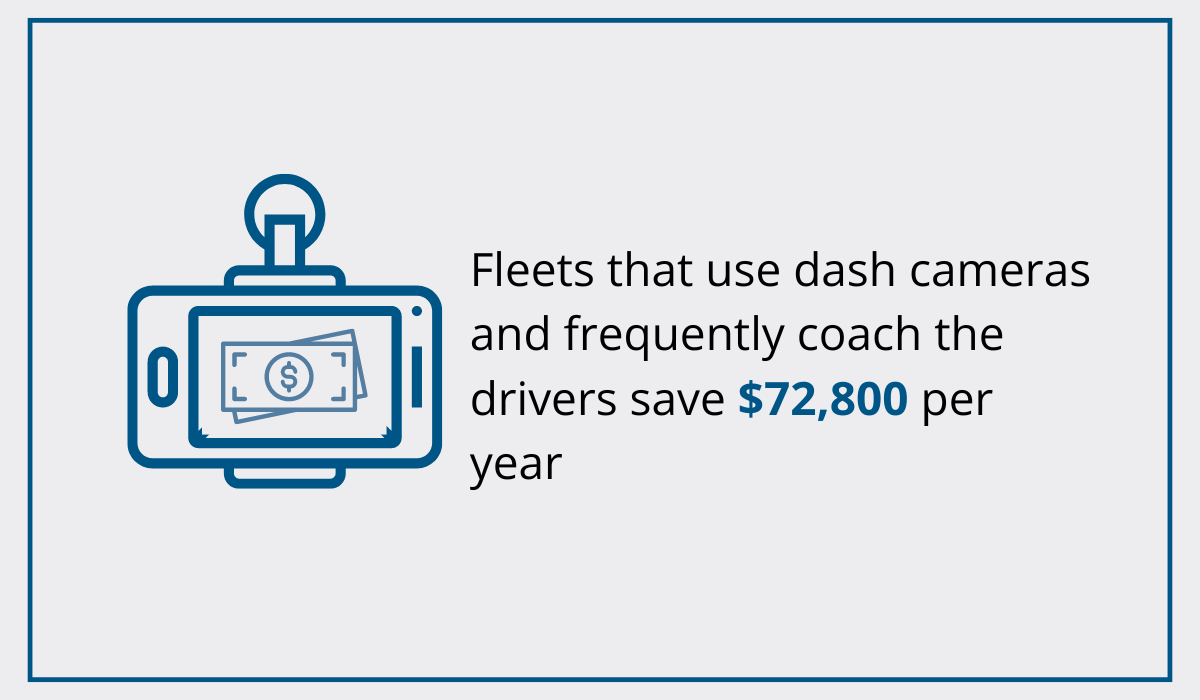
That’s definitely no pocket change.
Now, while dash cams still aren’t as commonly used in fleet operations as GPS is, their value in bolstering road safety absolutely shouldn’t be underestimated.
They promote accountability, improve driving habits, aid in proving drivers’ innocence in road incidents, and often prevent accidents from happening altogether.
Essentially, with these little cameras on board, you can breathe a bit easier knowing that your team has that extra layer of protection when en route.
Vehicle Sensors
Telematics definitely isn’t just about pinpointing asset locations anymore.
Now, thanks to a wide variety of vehicle sensors out there, you can capture and monitor a diverse range of parameters relating to asset conditions, performance, and driver behavior, including:
- Speed
- Acceleration
- Fuel levels
- Braking patterns
- Environmental conditions within the vehicle (temperature, humidity, or air pressure)
- Tire pressure
- Seatbelt use
And the list goes on.
With such rich vehicle and driver data, knowing your fleet inside-out finally becomes possible.
And the benefits?
Too many to count, says Norty Turner, Principal at Woodland Management:
“Telematics data is an essential ingredient to an effective fleet strategy that delivers positive impact to the business. By providing managers with the visibility they need of the location and utilization of equipment, telematics-based fleet tracking combined with equipment management software can make jobsites more productive, cut project costs and increase the bottom line.”
Improved asset allocation? Check.
Increased vehicle up time? Check.
More effective maintenance strategy? Check.
Put simply, with the information that comes through these sensors, you become much smarter about managing your fleet throughout its entire lifecycle.
As a result, you not only prevent overspending on repairs or replacements but also learn how to better care for your fleet, extending the lifespans of your vehicles and their components in the process.
Del Lisk, a retired traffic safety professional and a former Vice President of Safety Services for Lytx, agrees.
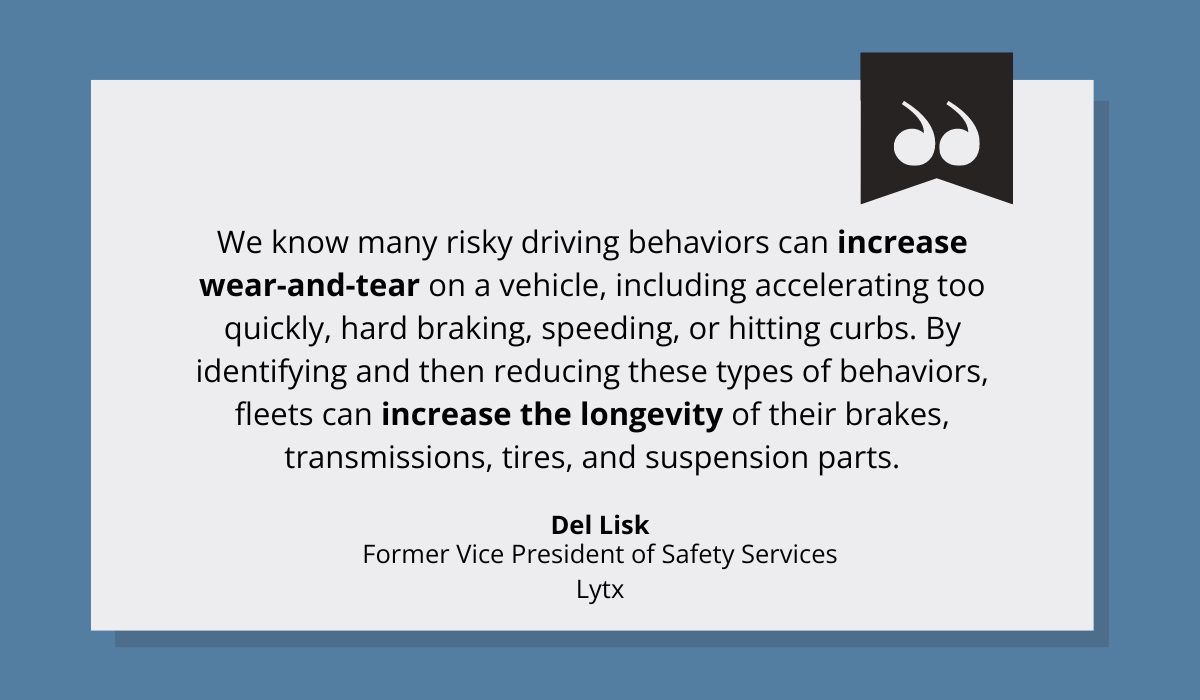
He emphasizes that, with this telematics data, you can promptly detect unwanted behaviors and areas for improvement, which enables you to take swift action and rectify situations before they escalate and start causing you trouble.
Be careful, though, not to get overwhelmed by the sheer volume of information generated by these sensors.
The reality is, tracking every single aspect of your fleet probably isn’t necessary and could, in fact, slow you down and disrupt your operations.
Therefore, if you’re considering investing in telematics devices, focus on addressing your specific needs instead of acquiring as many sensors as possible.
For instance, if your goal is to reduce accidents on the road, prioritize sensors that monitor driver behavior rather than, say, the air pressure inside the vehicle.
Falling into the trap of believing that more data is always better is a common mistake and a guaranteed way to never unlock the full potential of both your telematics system and your fleet.
Onboard Diagnostics
Onboard diagnostic (OBD) devices are hardware components typically plugged into the OBD-II port of a vehicle—a standard diagnostic port found under the dashboard of most vehicles manufactured after 1996.

Perhaps the most valuable feature of this technology lies in its capability to monitor, interpret, and notify you of diagnostic fault codes (DTCs) in real time.
These codes pinpoint specific issues within the vehicle’s various systems, facilitating easier, quicker, more effective diagnosis and, of course, resolution of problems.
Put differently, OBD-generated DTCs considerably simplify maintenance, prolonging assets’ operational lifespan, cutting maintenance costs, and even minimizing costly downtime.
In fact, did you know that by monitoring diagnostic trouble codes and vehicle health through telematics, you can actually increase asset uptime by 25%?

After all, the main goal of any fleet manager is to get the most out of their assets.
Onboard diagnostics, by serving as a foundation for preventive maintenance strategy, makes that possible.
However, just like with vehicle sensors, there’s a real risk of data overload when using this technology.
Jon White, Co-founder of CST Fleet Services and President of Jon White Inc., elaborates on why that is.

You see, not all diagnostic trouble codes are created equal.
Some of them may indicate critical issues, such as engine misfires, overheating, or brake system malfunctions, while others may not.
Onboard diagnostics simply lack the ability to distinguish between the two.
Therefore, in addition to using these devices, it’s advisable to arm yourself with software featuring robust reporting, data filtration, and prioritization capabilities.
Such systems can categorize DTCs based on severity levels, flagging critical issues that pose immediate safety risks or affect an asset’s functionality as high priority, while marking less urgent ones as medium or low priority.
This allows you to focus on resolving more serious problems first, and keep your assets road-ready for much longer.
Electronic Logging Devices (ELDs)
Electronic logging devices (ELDs) are tablet computers installed in vehicles to automatically record various data concerning vehicle operation and driver activity, primarily focusing on driver hours of service (HOS) and record of duty status (RODS).
In fact, since December 18, 2017, the United States Federal Motor Carrier Safety Administration has mandated the use of this technology for most commercial vehicles in order to mitigate fatigued driving, a major contributor to accidents and fatalities on highways.
But, what exactly does an ELD track?
Well, it captures a wide range of information essential for accurate hours of service tracking and optimization of available driver hours, including:
- Vehicle, motor carrier, and driver identification
- Date and time
- Geographic location
- Miles traveled
- Driver log-on/log-off
- Hours of service
- Duty status changes
Now, the major benefit of this technology is that it simplifies compliance with federal hours of service laws.
By replacing traditional paper logbooks, notorious for human error and manipulation, these devices streamline record-keeping, making sure that HOS records are accurate, up-to-date, and tamper-proof.
Ultimately, this guarantees that drivers adhere to regulations regarding maximum driving and minimum rest periods.
At the time of the adoption of the EDL rule, former U.S. Transportation Secretary Anthony Foxx said this is precisely what the transportation industry needs.
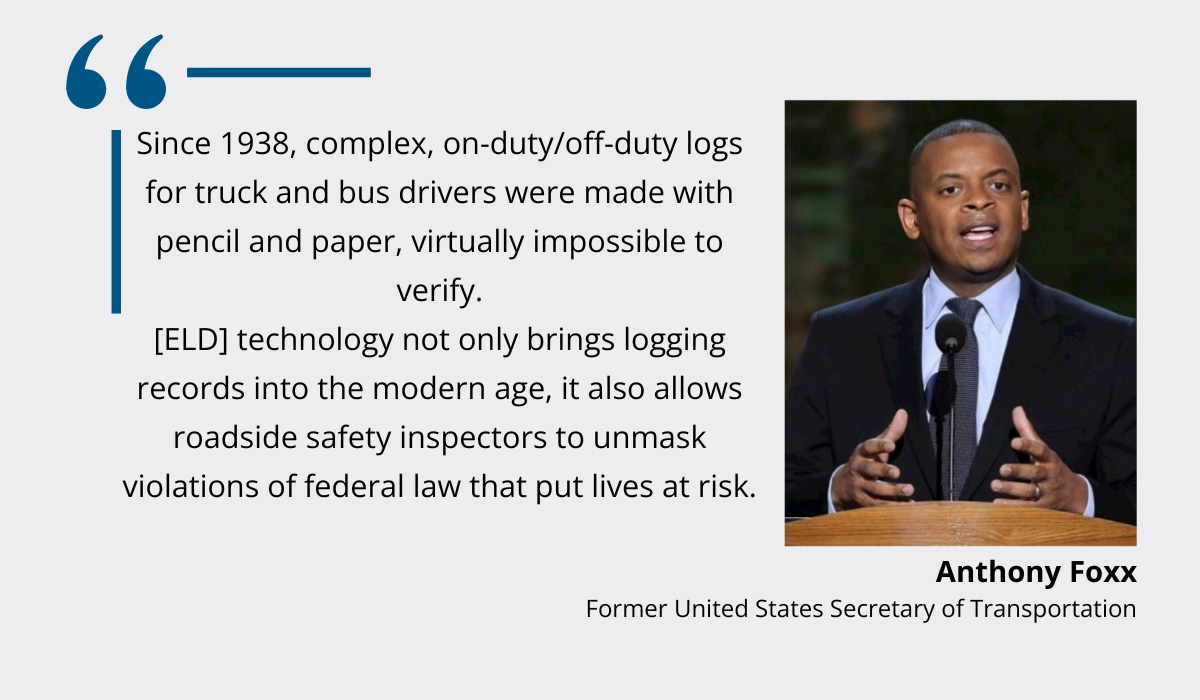
After all, EDLs promote transparency in driver movement and activities, significantly reducing opportunities for non-compliance with the law.
The second advantage of electronic logging devices is improved driver safety.
By preventing drivers from exceeding their allotted driving time, these devices are supposed to prevent driver fatigue and reduce the risk of accidents caused by tired or overworked drivers.
At least, that’s the idea.
However, as of now, there’s really no concrete evidence that suggests that is truly the case.
As a matter of fact, some recent articles argue that the number of accidents has actually increased since the ELD mandate began.
The reason for this may be the technology’s inflexibility.
Karen Levy, an associate professor in the Department of Information Science at Cornell University, explains:
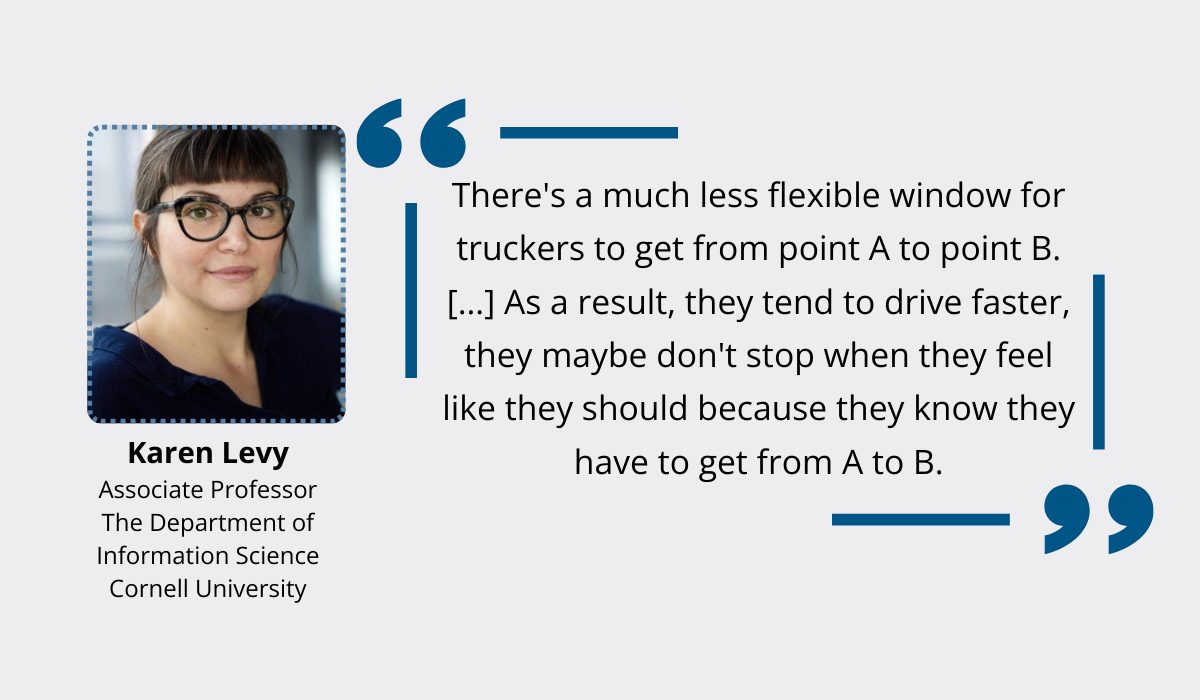
The bottom line is this: ELDs probably aren’t going anywhere and are, indeed, very useful when it comes to record-keeping and ensuring compliance.
But if your aim is to boost driver safety, you’ll likely need to supplement them with other devices mentioned in this article, as well as educate your drivers on how to manage their time more effectively.
Conclusion
Now, if you’re wondering if you truly need to invest your hard-earned money in all of these devices, don’t worry—you don’t.
Depending on your specific needs, you might need one or a combination of a few, but purchasing every single telematics device under the Sun isn’t necessary.
Ask yourself: What do I truly want to achieve with telematics?
Do you want to reduce missing equipment and theft?
Perhaps look into GPS trackers for precise location tracking.
Are driver-caused accidents and unsafe driving your biggest concerns?
Consider investing in dash cameras or driver behavior monitoring sensors.
By focusing exclusively on your fleet goals, you’ll not only avoid overspending on unnecessary technology, but also ensure you maximize your new system’s potential, and take your fleet management strategy to new heights.





